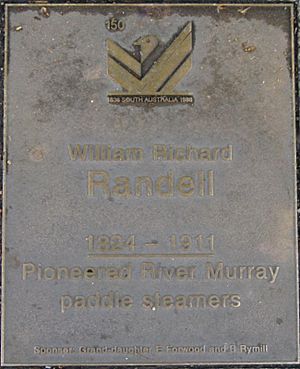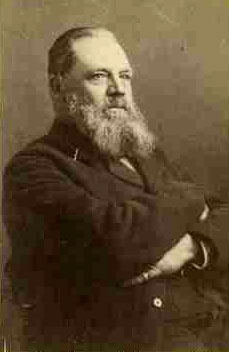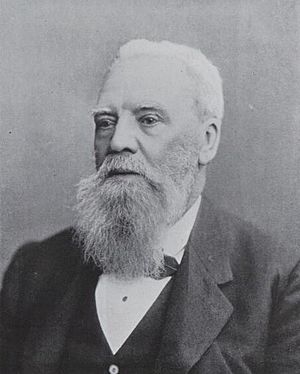William Randell facts for kids

William Richard Randell (born May 2, 1824 – died March 4, 1911) was an important Australian pioneer and politician. People often called him "Captain Randell." He was born in Devon, England, and moved to the new colony of South Australia in 1837 with his family.
He became famous for starting the riverboat industry on the Murray River. These boats helped transport goods and people. Later, he also served as a politician. He represented the Electoral district of Gumeracha in the South Australian House of Assembly from 1893 to 1899.
His son, (Richard) Murray Randell (born February 2, 1863 – died March 6, 1952), also became known as "Captain Randell." He took over his father's riverboat business.
Contents
Early Life in Australia
William Richard Randell was the oldest son of William Beavis Randell and Mary Ann Elliott Randell. He was born in England and went to school in Exeter. His family moved to Adelaide in 1837 on a ship called the "Hartley." They arrived at Holdfast Bay on October 20, 1837.
His father was going to manage a flour mill for the South Australian Company. The family first lived in a large tent. In 1839, they moved into a house called "Park Cottage" near the Torrens River.
In 1840, William's father bought a large area of land. He called it "Kenton Park." He built a home there in 1844 and a mill called "Kenton Mill." William Richard Randell was the first manager of this mill, which started working in 1848. In 1852, his father planned out the town of Gumeracha.
Building the "Mary Ann"
While managing the mill, William Randell also helped his father and brothers with their big property. This land stretched all the way to the Murray River. He often had to move cattle to the riverbanks. He dreamed of using steam-powered boats to move goods between South Australia and Victoria. At that time, many people were leaving South Australia to find gold in Victoria.
In 1852, Randell decided to build a steamboat. He had no experience building boats! He hired local carpenters to build the frame of a boat. It was 55-foot-long (17 m) and 9-foot beam (2.7 m). This boat was designed to float in shallow water and could carry 20 tons of cargo.
The boat was built in Gumeracha. Then, it was taken apart and moved by bullock cart to a place called Noa No landing, near the present-day town of Mannum. There, it was put back together and covered with local redgum wood.
Randell named the boat the Mary Ann, after his mother. It had an engine that made 8 horsepower. The boiler, however, was not very good. The Mary Ann's first short trip was on February 19, 1853. On March 4, she arrived at Goolwa for her first official voyage. The lieutenant-governor, Sir Henry Young, and many people greeted her.
On March 25, 1853, Randell steered the Mary Ann to Penn's Reach, a few miles north of Morgan. Low water levels stopped him from going further. The next year, he reached Swan Hill, which is 1,000 miles (1,600 km) from the sea at Goolwa.
Another captain, Captain Cadell, later won a government prize for the first useful cargo boat. His boat was called the Lady Augusta. The Mary Ann was not part of this competition. The Mary Ann was later rebuilt into a two-hulled boat called Gemini.
Growing the Riverboat Business
William Randell moved his base from Noa No because it flooded too much. He built a small house, which was the start of the town of Mannum. He also built a dry-dock there.
His second boat was the "Gemini." It had two hulls and one paddle wheel. Even though it was small, it made some amazing trips into New South Wales. It reached Lang's Crossing (where Hay is now). In 1859, it reached Brewarrina and later even Walgett.
Randell built or ordered many more steamboats. Some of their names were "Bogan," "Bunyip," "Ariel," "Nil Desperandum," "Corowa," "Waragery," "Tyro," and "Ruby." For about 20 years, Wentworth, New South Wales, was Randell's main base. From there, he managed his growing fleet of boats and the increasing trade on the Murray-Darling rivers.
Randell built a home called "Bleak House" in Mannum. He also built a floating dock, a wharf, and a warehouse. Around 1860, Mannum was very busy. About 20,000 bales of wool were unloaded there. Horse teams then carried the wool to Port Adelaide.
Randell became a Justice of the peace in New South Wales in 1861 and in South Australia in 1873. After his father died in 1876, Randell returned to Gumeracha. He was less involved with the river trade after that. His son, (Richard) Murray Randell, took over the fleet and the title "Captain Randell."
Randell's Place in History
Many people have written about William Randell's importance. Sir Richard Graves MacDonnell, who used to be the Governor of South Australia, gave a speech in 1863. He said that William Randell was likely the first person to navigate the Murray River in a steamboat.
MacDonnell noted that Randell started his journey in 1853, just before Captain Cadell's well-known trip. Because Cadell's trip was official and had more attention, Randell's achievements were sometimes overlooked.
However, Randell started first, even with fewer resources and a boat he built himself. He kept going until he reached Echuca, which was much further than where Captain Cadell reached. In 1859, Randell went up the Murray again and then up the Darling River.
MacDonnell remembered meeting Randell on the Darling River. Randell's steamboat was "crazy and broken-winded," making funny wheezing noises. But Randell managed to go even further up the river than MacDonnell and Cadell had. Thanks to a flood, he reached Fort Bourke. He then went up other branches of the Darling, like the Barwon and Namoi.
After comparing notes, MacDonnell believed Randell traveled about 1,800 miles from where the Darling joins the Murray. This meant he traveled about 2,400 miles from the sea. This was a very long journey, almost double the length of many European rivers. Randell's trips showed how important the rivers could be for travel and trade in Australia.
Family Life
William Randell married Elizabeth Ann "Annie" Nickels on December 24, 1853. They had many children, including:
- Captain William Beavis Randell (1856–1917) was a famous motor-cyclist.
- Elizabeth Hannah Randell (1858–1940).
- Mary Ann Randell (1860–1931).
- Sarah Hamlin Randell (1862–1902).
- (Richard) Murray Randell (1863–1952) was known as "Captain Randell." He managed the family's paddle steamer fleet for 56 years.
- James Percy Randell (1867–1914).
- Rosemund Randell (1868–1896).
- Albert Wentworth Randell (1870–1923), also called "Captain Randell."
- Mabel Daisy Darling Randell (1872–1937).
- Millicent Beatrice Swaine Randell (1875–1926).
- Alfred Swaine Randell (c. 1879–1953).
Images for kids




